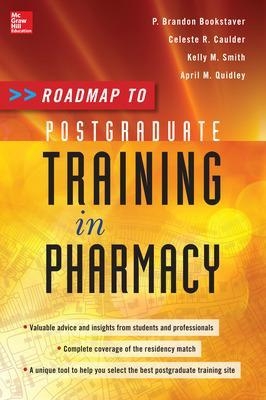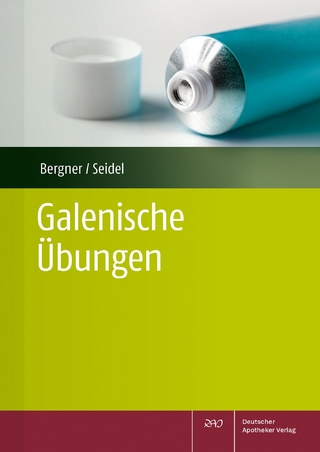
Roadmap to Postgraduate Training in Pharmacy
McGraw-Hill Medical (Verlag)
978-0-07-178875-5 (ISBN)
- Titel z.Zt. nicht lieferbar
- Versandkostenfrei innerhalb Deutschlands
- Auch auf Rechnung
- Verfügbarkeit in der Filiale vor Ort prüfen
- Artikel merken
Publisher's Note: Products purchased from Third Party sellers are not guaranteed by the publisher for quality, authenticity, or access to any online entitlements included with the product.
A must read for every pharmacy student
Roadmap to Postgraduate Training in Pharmacy provides the information and expertise pharmacy students need to make confident, informed decisions regarding residency programs, fellowships, and additional degrees.
This career-building book includes:
Contributions from experienced professionals and new practitioners
A timeline for the residency application process includes consideration of programs, preparing for annual meetings, completing applications, the interview process, and forming rank lists
Details institutional differences in residency training
Postgraduate Pharmacy Training: Going the Distance
A Roadmap to Postgraduate Training in Pharmacy
Table of Contents
Chapter 1: History of residency training
Written from the perspective of a seasoned professional, this chapter includes:
· Description of the beginnings of residency training
· Changes in residency training with transition to all-PharmD degrees in pharmacy
· Growth in the types of specialties and numbers of programs and positions
· Pharmacy organizations’ role in the development of residency training
Chapter 2: Introduction – The What and Whys of Post Graduate Training
This chapter defines post graduate training, mentions, and differentiates the various options including:
· Residencies
· Fellowships
· Similarities and differences between residency and fellowship training
· Additional degree programs complementary to the Doctor of Pharmacy degree
Chapter 3: Why should I complete a residency?
This chapter discusses the advantages of residency training including:
· Benefits of residency/fellowship training
· What will a residency provide for me
· Pharmacy organization opinions and statements on residency training
· Residency training from the employer perspective
Chapter 4: The role of accreditation in postgraduate training
This chapter defines accreditation and outlines:
· The significance of accreditation in residency training
· Organizations granting residency accreditation
· Role of fellowship training and its accreditation processes (or lack of)
Chapter 5: Things to expect during a residency year
This chapter will explain the activities for a residency year including:
· Major projects
· Medication Use Evaluations
· Regional resident conferences
· Other common resident activities (inservices, journal clubs)
· Pharmacy practice and drug distribution activities
· Clinical on call services
· General day to day activities of a resident
Chapter 6: Role of research in residency training
A major research project is a significant portion of the residency year, this chapter will outline important details related to these activities:
· Purpose and objectives of the residency research project
· ASHP standards related to research activities
· Applicability of research activities to daily practice
Chapter 7: Selecting the ideal residency program
This chapter provides information on things to consider when choosing to pursue residency training
· Decision to pursue residency training
· Psychosocial aspects of residency training including work-life balance and stress management
· Selecting the residency program that best fits with the candidate
Chapter 8: The “Ideal” Residency Candidate”
Written with input from program directors, this chapter will provide information on the “ideal residency candidate” including:
· Making sure career goals align with what the institution provides
· CV is organized and complete
· Things NOT to do (misspellings etc)
· How to conduct oneself on an interview
· Professional communications
Chapter 9: Preparing for the ASHP Midyear Clinical Meeting (MCM)
This chapter will include a detailed explanation on the following:
· Online Residency Directory
· Curriculum vitae preparation for Residency Showcase
· Correspondence with programs prior to the MCM
· What to prepare prior to Residency showcase
· What to prepare for participation in Personal Placement Service (PPS) and its role in obtaining postgraduate training
Chapter 10: Activities at the Midyear Clinical Meeting
This chapter will discuss applicant activities at the MCM and emphasize the importance of professionalism. It will include topics on:
· Navigating the Residency Showcase
· Interactions with programs at the showcase including a list of sample questions
· Program receptions and attendance
· Structure and function of PPS
Chapter 11: Post-MCM activities and the residency application process “The Holiday Rush”
This chapter will provide the reader with information on the tasks to be completed after MCM including the application process. Professionalism will be re-emphasized and the chapter will discuss:
· Thank you letters
· Deciding which programs to submit applications
· Completing applications
· Letters of intent
· Updating the Curriculum vitae
· How to ask for letters of recommendation
· Letters of recommendation/recommendation forms
· Meeting deadlines
· Applying to the match
Chapter 12: Interview Process
This chapter includes discussion on considerations, expectations, and unique aspects of the interview process including:
· How do interview offers occur
· What to expect from an onsite interview
· Follow-up after an onsite interview
· Sample interview questions
· Interview etiquette
Chapter 13: Match Process
This chapter includes discussion on the match process including:
· How does the Match process work
· How do you
submit your ranking
· How does an applicant find out their match results
· What happens if I don’t match? (The scramble)
Chapter 14: Various types of residencies - PGY1 Pharmacy Practice
Written with input from program directors and preceptors at a variety of institutions this chapter describes the unique aspects of PGY1 programs including:
· Overall objective of PGY1 programs in creating a pharmacy generalist
· Similarities and differences between Programs at academic medical centers, urban community hospitals, smaller community hospitals, programs at Veterans Affairs hospitals
· Required and elective rotation opportunities to consider
· Clinical “On-call” activities
Chapter 15: PGY1- Community Pharmacy Residencies
This chapter provides information on the unique features and considerations for residencies in community pharmacy practice including:
· Accreditation as a joint effort of ASHP and the American Pharmacists Association (APhA)
· Corporate and academic support of programs
· Learning objectives specific to community pharmacy
· Unique activities of community pharmacy training
· Personal reflections on community pharmacy training
Chapter 16: PGY1 Community Pharmacy Residency Application Process
Written by individuals involved in Community Pharmacy Residency training, this chapter includes:
· Information on the APhA residency directory and its resources
· Searching for and interacting with residency programs at the APhA Annual meeting
· Differences in the application process for Community Pharmacy Residency Programs
Chapter 17: Various types of residencies - PGY1- Managed Care Pharmacy
This chapter includes discussion on considerations and unique aspects of managed care pharmacy residencies including:
· The roles of ASHP and the Academy of Managed Care Pharmacy (AMCP)
· Types of sponsoring organizations
· Learning objectives specific to managed care pharmacy programs
· Unique activities of managed care training
· Personal reflections on managed care training
Chapter 18: PGY1 Managed Care Pharmacy Residency Application Process
Written by individuals involved in Managed Care Pharmacy training, this chapter includes:
· Information on the Academy of Managed Care Pharmacy (AMCP) and its resources for residency training
· Unique aspects of the Managed Care Pharmacy Application process
Chapter 19: Various types of residencies - PGY2 - Specialty Residencies
Written with input and perspective from program directors from each specialty, this chapter includes brief information on the important characteristics to consider when selecting a PGY2 specialty. Specific information in this chapter will include:
· Difference between PGY1 and PGY2 training activities and expectations
· Overall objective of PGY2 program in creating a pharmacy specialist
· Benefits of pursuing PGY2 residency after PGY1 completion
Chapter 20 - 40: Types of PGY2 Specialty Residencies
(***Chapters 20 - 40 will be dedicated to each of the types of specialty residencies including: Administration, Ambulatory Care, Cardiology, Critical Care, Drug Information, Emergency Medicine, Geriatrics, Infectious Diseases and HIV, Internal Medicine, Medication use safety, Nephrology, Nuclear, Nutrition Support, Oncology, Palliative Care/Pain Management, Pediatric Oncology, Pediatrics, Pharmacotherapy, Pharmacy Informatics, Psychiatric Pharmacy, Transplantation- Immunology and Solid Organ Transplant***)
Written with input and perspective from specialty program directors, this chapter includes brief information on the specialty residency:
· Similarities and differences between Programs at academic medical centers, urban community hospitals, smaller community hospitals, programs at Veterans Affairs hospitals
· Required and elective rotation opportunities to consider
· Clinical “On-call” activities
· Learning objectives specific to the specialty residency
· Unique activities of training for the specialty residency
· Personal reflections on the specialty residency
Chapter 41: PGY2 Matching Process
Written with input from PGY2 residency directors this chapter will include:
· Difference between PGY1 and PGY2 matching processes
· Unique PGY2 interview expectations
· Early commitment
· Match process for PGY 2 Specialty Residencies
Chapter 42: Life after the residency Match
This chapter provides information on preparing to start the residency and familiarizing soon-to-be residents on RLS and ResiTrack including:
· Relocation
· Residency learning system (RLS)
· ResiTrak
· Licensure requirements
· Skills and knowledge preparation including the “Top 10 Things to Ask Every Preceptor”
o The list covers keeping up with the medical literature, technology in the workplace, work-life balance, etc.
Chapter 43: Fellowships
Written by pharmacists involved in fellowship training, this chapter contains:
· The benefits of fellowship training
· General features of fellowship training
· Considerations in selecting a fellowship program
Chapter 44: Degree Programs
Written by individuals with an academic perspective on degree programs, this chapter contains:
· Description of degree programs including Master of Business Administration, Master of Public Health, Master of Clinical Research, and Doctor of Philosophy
· Enhanced skills and career opportunities available after these degree programs
· Timing of degree programs in relation to the Doctor of Pharmacy curriculum and residency/fellowship training (if applicable)
Chapter 45: Career Options after residency training:
This chapter describes the unique career opportunities available after residency training including:
· Clinical pharmacy positions at urban and rural institutions
· Clinical pharmacy faculty positions
· SPAN>Pharmaceutical industry positions
· Administrative positions
Chapter 46: Conclusion
Written from the perspective of the ASHP Commission on Credentialing, the book will conclude with a discussion on the future of residency training including:
· Increasing necessity of residency training for involvement in clinical practice
· Anticipated changes in residency training
· Future of Residency Training
Appendix 1: Suggested timeline of events
Appendix 2: Sample letters and CVs
Chapter Consistencies
· Chapter excerpt or introduction at beginning of each chapter
· “Potent Quotables”
o Blurbs, personal accounts set off in the margins sporadically
· Chapter highlights at the end of each chapter
| Erscheint lt. Verlag | 16.3.2013 |
|---|---|
| Zusatzinfo | 20 Illustrations |
| Verlagsort | New York |
| Sprache | englisch |
| Maße | 218 x 229 mm |
| Gewicht | 540 g |
| Themenwelt | Medizin / Pharmazie ► Pflege |
| Medizin / Pharmazie ► Pharmazie ► PTA / PKA | |
| ISBN-10 | 0-07-178875-1 / 0071788751 |
| ISBN-13 | 978-0-07-178875-5 / 9780071788755 |
| Zustand | Neuware |
| Informationen gemäß Produktsicherheitsverordnung (GPSR) | |
| Haben Sie eine Frage zum Produkt? |
aus dem Bereich


